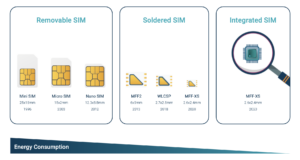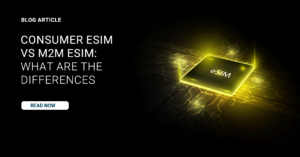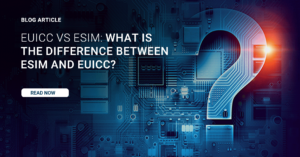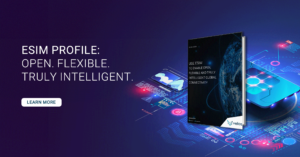Everything You Need to Know About eSIM for IoT
In today’s rapidly evolving digital landscape, the Internet of Things (IoT) has become increasingly prevalent in various industries, revolutionizing the way businesses operate and interact with their surroundings. As IoT devices continue to grow in number and complexity, the need for reliable connectivity solutions has become more crucial than ever. This is where embedded SIM (eSIM) technology comes into play.
This in-depth eSIM guide for IoT is designed to provide businesses with a comprehensive overview of eSIM technology within IoT environments. By delving into the intricacies of eSIM solutions, this guide aims to equip companies with the knowledge and insights needed to leverage the power of eSIM technology in their IoT projects effectively.
Content
- Introduction
- Various eSIM terminologies
- Consumer eSIM vs.M2M/IoT eSIM: Understanding the Distinctions
- Navigating eUICC vs eSIM
- Understanding Multi-IMSI vs eUICC
- Benefits of using eSIM for IoT Devices
- How eSIM Works in IoT Applications
- Key Features of eSIM Technology
- How to implement eSIM in your IoT Devices?
- Choosing the Right eSIM Provider for Your IoT Project
- Managing eSIM Profiles and Connectivity
- Future Trends in eSIM Technology for IoT
- Future-proof your Business with Velos IoT eSIM Solutions
Introduction
In the ever-evolving realm of the Internet of Things (IoT), a revolutionary shift has taken place with the advent of eSIM technology. This innovation is revolutionising the global connectivity landscape for IoT solutions. Traditional approaches often encounter challenges when it comes to fully unleashing the potential of IoT. Embedded SIM, or eSIM, has emerged as a critical facilitator for improving connectivity and security in IoT devices. eSIM technology empowers users to choose and adjust service provider profiles based on their specific requirements or business regulations. In this in-depth guide, let’s explore the complexities of eSIM technology for IoT.
The inception of SIM cards dates back to 1991, when integrated circuits, akin to the size of a credit card, first made their debut. As the years progressed, SIM cards transformed, shrinking in size while expanding in functionalities. The traditional SIM cards presented a set of challenges, notably carrier lock-ins that hindered the seamless transition between carriers or the adoption of new cellular technologies.
In response to these obstacles, the eSIM technology emerged as a groundbreaking solution. These innovative chips allowed for remote, over-the-air (OTA) provisioning, eliminating the necessity for physical SIM card replacements when switching carriers or upgrading network technologies.
A notable advantage of eSIM technology lies in its diverse form factors, tailored to meet the distinctive requirements of various IoT devices. This adaptability empowers IoT solution designers to focus on meeting customer-centric needs without being restricted by specific SIM sizes or carrier network prerequisites.
Various eSIM terminologies
In the diverse landscape of eSIM technology, various types are tailored to specific applications and user scenarios, which are essential for navigating the dynamic realm of connected devices. Let’s delve into the primary categories of eSIMs:
– Consumer eSIM: Tailored for individual users, these eSIMs are commonly found in smartphones, tablets, and wearables, enabling seamless operator switching without the need for a physical SIM card.
– M2M/IoT eSIM: Designed for Industrial Internet of Things applications, this eSIM for IoT facilitate remote device activation, configuration, and management within IoT ecosystems, which is crucial for connecting sensors and machinery.
– eUICC (Embedded Universal Integrated Circuit Card): Serving as the hardware component of an eSIM, eUICCs are embedded circuits that securely store and manage multiple SIM profiles, commonly used in IoT devices with soldered SIMs.
– Multi-IMSI (International Mobile Subscriber Identity): Enabling devices in eSIM-enabled IoT contexts to switch dynamically between multiple IMSI numbers associated with different mobile networks.
– Consumer Removable eSIM: Combining traditional SIM card features with embedded technology, these eSIMs are easily replaceable by end-users, offering both eSIM functionality and the option for physical removal.
– Industrial-Grade eSIM: Engineered to withstand harsh industrial conditions, these eSIMs meet rugged requirements and are ideal for IoT applications in challenging environments with enhanced durability and reliability.
– Global Platform (GP) eSIM: Conforming to GlobalPlatform specifications, GP eSIMs adhere to global standards for secure chip technology, ensuring interoperability and security across diverse devices and networks.
– GSMA-compliant eSIM: Following GSMA standards, these eSIMs comply with specifications set by the GSM Association, ensuring compatibility and interoperability within the mobile ecosystem.

Consumer eSIM vs.M2M/IoT eSIM: Understanding the Distinctions
In navigating the ever-changing realm of eSIM technology for IoT, it is essential to discern between consumer eSIM and M2M/IoT eSIM. While both share the core concept of remote provisioning, they cater to distinct purposes tailored to their specific applications.
Consumer eSIM:
Target Devices: Primarily crafted for consumer gadgets like mobile phones, tablets, and wearables.
Control and Privacy: Adhering to strict privacy regulations, remote activation and management can be challenging due to individual user protections.
Application: Ideal for personal devices where end-users have direct control over activation, setup, and maintenance.
M2M/IoT eSIM:
Target Devices: eSIM for IoT, customized for Industrial Internet of Things (IoT) applications, encompassing sensors, machinery, and robust devices in demanding environments.
Control and Privacy: Aligned with organisational requirements, facilitating seamless remote activation, setup, and management of eSIMs and associated IoT devices.
Application: Crucial for industrial environments where devices may have non-standard configurations, requiring rugged designs and remote management for optimal efficiency.
Understanding these distinctions is crucial for businesses implementing IoT solutions. While consumer eSIMs focus on personal devices with a priority on user privacy, industrial-grade M2M/IoT eSIMs are designed to meet the unique demands of complex industrial settings, providing remote control and robust management features. This differentiation ensures that the selected eSIM solution seamlessly aligns with the intended application, enhancing efficiency, scalability, and control over IoT deployments.
Navigating eUICC vs eSIM
The distinction between eUICC and eSIM is often blurred, with many media sources using the terms interchangeably. However, they represent two distinct technologies.
eSIM encompasses the entire service ecosystem, including SIM, eUICC, and platform, while eUICC specifically refers to the software enabling remote provisioning. The eSIM technology can exist across various form factors, such as the embedded SIM (MFF2), which is soldered onto device circuit boards. This confusion arises as both MFF2 and eUICC are commonly referred to as eSIM.
eUICC, or Embedded Universal Integrated Circuit Card, enhances traditional SIM functionalities by enabling over-the-air (OTA) provisioning of multiple network operator profiles from a central management point. This capability allows for remote management and deletion of SIM profiles, offering unprecedented flexibility and efficiency. In contrast, the Universal Integrated Circuit Card (UICC) primarily runs the SIM application and stores user information, while eUICC expands these capabilities to enable seamless OTA provisioning and management, revolutionising how devices are connected and managed in the IoT ecosystem.
Understanding Multi-IMSI vs eUICC
While both Multi-IMSI and eUICC technologies provide solutions for carrier switching and offer multiple profiles, they differ significantly in their core functionalities. Here’s a breakdown of each:
Multi-IMSI:
- Definition: Multi-IMSI involves having multiple SIM profiles on a single SIM card, each containing its unique International Mobile Subscriber Identity (IMSI).
- Industry Applications:
- Logistics and Fleet Management: Enables seamless switching between carriers, ensuring optimal connectivity during transportation.
- Global IoT Deployments: Ideal for manufacturers deploying devices globally, ensuring reliable connectivity across various regions.
- Roaming Applications: Facilitates automatic switching to the best available mobile network based on geographical location.
- Why You Might Choose Multi-IMSI:
- Cost-Effectiveness: Multi-IMSI is more cost-effective, automatically selecting networks with optimal signal strength and lower costs.
- Autonomous Switching: Enables autonomous switching, automatically selecting the best mobile network operators for your device.
- Well-Established: With a longer track record, multi-IMSI is a trusted technology with continuous improvements.
eUICC:
- Definition: As understood in the above section, eUICC is a permanent hardware component that enables remote provisioning and management of SIM profiles.
- Industry Applications:
- Healthcare IoT: Enables remote provisioning for medical devices, ensuring continuous connectivity and updates.
- Smart Cities: Streamlines network management for connected devices in urban environments with dynamic connectivity needs.
- Utilities and Energy: Facilitates over-the-air provisioning for devices in remote locations, reducing manual intervention.
- Why You Might Choose eUICC:
- Remote Provisioning: The significant advantage of eUICC lies in remote provisioning, facilitating dynamic changes to network subscriptions over the air (OTA).
- Reduced Hardware Dependence: eUICC eliminates reliance on physical SIM cards, reducing concerns about loss, damage, or misplacement.
- Suitable for Large Enterprises: Ideal for larger enterprises requiring frequent profile switching across geographical regions, offering flexibility and seamless connectivity.
Solutions like multi-IMSI and eUICC are pivotal in keeping businesses connected globally. These advanced network-switching technologies cater to the evolving needs of IoT devices. Understanding the nuances between multi-IMSI and eUICC is crucial for making informed decisions tailored to your business’s ongoing connectivity requirements.
You may also find the following of interest:
A Quick Introduction to Multi-IMSI and its Functions
Multi-IMSI and eUICC: Are they the same thing
Benefits of using eSIM for IoT Devices
eSIM technology offers many benefits for IoT devices, revolutionising how they connect and operate in the modern world. One key advantage is its enhanced flexibility, allowing IoT devices to seamlessly switch between different mobile networks without the hassle of physical SIM card swaps. This ensures continuous connectivity and enables devices to function optimally in diverse locations, ultimately reducing downtime and improving overall performance.
Moreover, eSIM technology significantly enhances scalability, making it easier for IoT deployments to grow and adapt to changing needs. With eSIM, organisations can effortlessly add new devices to their network and expand their operations without the constraints of traditional SIM cards. This scalability feature is essential for accommodating the increasing demands of IoT deployments in a dynamic and ever-evolving landscape.
Regarding cost-effectiveness, eSIM technology proves to be a game-changer for IoT devices. By eliminating the need for physical SIM cards and enabling seamless network switching, eSIM streamlines the logistics of managing SIM profiles for large-scale deployments. This reduces operational costs and simplifies the process of maintaining and updating IoT devices, ultimately leading to significant savings for businesses.
Overall, eSIM for IoT empowers IoT devices with unparalleled flexibility, scalability, and cost-effectiveness, paving the way for seamless connectivity, efficient operations, and maximised returns on investments in the IoT ecosystem.
How eSIM Works in IoT Applications
eSIM technology securely stores SIM profiles on a specialised chip embedded within the IoT device. This innovative approach streamlines the process of managing connectivity by allowing for remote provisioning of SIM profiles over-the-air. Gone are the days of physically swapping SIM cards, as eSIM technology enables seamless and hassle-free network connectivity.
With the power of eSIM, IoT devices can effortlessly tap into cellular networks worldwide, guaranteeing continuous connectivity and reliable data transmission regardless of location. This cutting-edge feature boosts the efficiency of IoT deployments and empowers businesses to thrive in an ever-changing digital landscape, where staying connected is crucial for operational success. By embracing eSIM technology, organisations can future-proof their IoT devices, minimise downtime, and maximise productivity in today’s interconnected world.

Key Features of eSIM Technology
Remote SIM Provisioning
eSIM technology revolutionises the way IoT devices connect and operate by enabling seamless and hassle-free network access. With the capability for remote SIM provisioning, organisations can easily manage and update SIM profiles over the air, eliminating the need for physical SIM card swaps. This streamlines connectivity and ensures continuous and reliable data transmission for IoT applications.
Learn more about remote SIM provisioning here.
Network Flexibility
eSIM technology provides unmatched network flexibility, empowering IoT devices to transition between various mobile networks effortlessly with seamless efficiency. This dynamic capability is crucial for IoT deployments operating in diverse environments and scenarios where uninterrupted connectivity is paramount. Whether in bustling urban settings or remote rural areas, eSIM technology ensures that devices stay connected and operational without disruptions, allowing for optimal performance and reliability at all times.
Enhanced security
In addition to providing secure data transmission, eSIM technology offers robust encryption protocols and authentication mechanisms to safeguard sensitive information from cyber threats and unauthorised access. With built-in security features such as secure boot processes, tamper-resistant hardware, and remote data wiping capabilities, eSIM ensures that valuable data remains protected at all times. By prioritising data security and privacy, eSIM technology not only shields IoT devices from potential breaches but also instils confidence in businesses to leverage the full potential of connected technologies without compromising confidentiality or integrity.
IoT Ecosystems Compatibility
Furthermore, eSIM technology ensures interoperability with a wide range of IoT platforms and devices, enhancing interconnected systems’ overall connectivity and functionality. By seamlessly integrating with existing ecosystems, organisations can unlock new opportunities for innovation and collaboration in the IoT space. This compatibility not only future-proofs IoT devices but also fosters a conducive environment for growth and development in the ever-evolving digital landscape. Embracing eSIM technology is not just about staying ahead; it’s about creating a sustainable foundation for success in the interconnected world of tomorrow.
Overall, eSIM technology is a game-changer for IoT applications, offering a range of features that enhance connectivity, security, and efficiency for connected devices.
How to implement eSIM in your IoT Devices?
Implementing eSIM technology in your IoT devices is a strategic move that can revolutionise how your devices connect and operate. To seamlessly integrate eSIM into your IoT project, follow these key steps:
1. Evaluate compatibility
Before implementing eSIM technology, ensure your IoT devices are compatible with eSIM functionality. Check if your devices have the hardware and software capabilities to support eSIM integration.
2. Choose the right eSIM provider
Select an eSIM provider with extensive network coverage, competitive pricing, robust technical support, and scalable solutions. A reliable eSIM provider can make a significant difference in the performance and efficiency of your IoT devices.
3. Develop a deployment strategy
Create a detailed deployment strategy that outlines the process of integrating eSIM into your IoT devices. Consider factors such as SIM provisioning, network switching, and security measures to ensure a smooth implementation process.
4. Conduct thorough testing
Before deploying eSIM technology in your IoT devices, conduct thorough testing to ensure compatibility, functionality, and security. Test various scenarios, such as network switching and data transmission, to identify and address potential issues.
5. Train your team
Provide training to your team members on managing and maintaining eSIM profiles, troubleshooting connectivity issues, and leveraging eSIM technology’s benefits. Empowering your team with the necessary skills and knowledge will ensure the successful implementation and operation of eSIM in your IoT devices.
By following these steps, you can effectively implement eSIM technology in your IoT devices and unlock a world of possibilities for seamless connectivity, enhanced security, and optimised performance in your IoT deployments.
Choosing the Right eSIM Provider for Your IoT Project
When selecting an eSIM provider for your IoT project, it is crucial to carefully evaluate several key factors that can ultimately impact the success and efficiency of your connected devices.
Does it have the network coverage you need?
One essential consideration is network coverage, as it determines the availability and reliability of connectivity for your IoT devices across different geographical locations. By partnering with an eSIM provider with extensive network coverage, you can ensure seamless data transmission and optimal performance for your IoT deployments, regardless of where they are deployed.
Is the pricing competitive?
In addition to network coverage, pricing is another critical aspect when choosing an eSIM provider. It is important to assess potential providers’ cost structure and pricing plans to ensure that they align with your budget and financial constraints. By selecting an eSIM provider that offers competitive pricing and transparent pricing models, you can effectively manage costs and maximise the return on investment for your IoT project.
Does it offer robust technical support?
Furthermore, technical support plays a vital role in the success of your IoT deployment. Choosing an eSIM provider that offers robust technical support and expertise can provide you with the necessary assistance and guidance to troubleshoot any issues that may arise during the deployment and operation of your connected devices. By partnering with a provider that prioritises technical support, you can ensure a smooth and seamless implementation of your IoT project.

Is the solution scalable?
Lastly, scalability is a crucial factor to consider when selecting an eSIM provider for your IoT project. As your IoT deployment grows and evolves, you need a provider that can accommodate your expanding needs and scale with your business. By choosing an eSIM provider that offers scalable solutions and flexible services, you can future-proof your IoT project and ensure that it can adapt to changing requirements and demands over time.
In conclusion, selecting the right eSIM provider for your IoT project is a strategic decision that can significantly impact the performance, efficiency, and success of your connected devices. By carefully evaluating factors such as network coverage, pricing, technical support, and scalability, you can make an informed choice that ensures seamless connectivity and reliable data transmission for your IoT deployments.
Managing eSIM Profiles and Connectivity
What is a profile?
It’s the software that allows you to connect to a certain mobile operator.
What is a bootstrap profile?
A bootstrap profile is pre-loaded onto the device, facilitating instant connection to any available network worldwide right from the start.
What is a fallback profile?
An eSIM fallback profile serves as a safety net for devices, enabling them to navigate through scenarios where the primary profile encounters coverage gaps or becomes inaccessible. It acts as a reliable network to which your device automatically switches in times of need.
What is a production profile?
A production profile is utilised in the deployment of IoT applications and is the designated profile following the adjustment of the eSIM bootstrap profile. Typically, this profile is tailored to the country where the device operates.
The Importance of Managing eSIM Profiles and Connectivity
Effectively managing eSIM profiles is crucial for ensuring seamless connectivity and optimal performance of IoT devices. Organisations can maintain secure and reliable network access for their connected devices by actively monitoring and updating profiles. This involves overseeing the configuration of bootstrap, fallback, and production profiles to guarantee uninterrupted data transmission and smooth network transition.
Furthermore, managing connectivity is essential for maintaining the efficiency of IoT deployments. Organisations must monitor network coverage, signal strength, and data usage to identify potential issues impacting connectivity. By proactively addressing connectivity challenges and optimising network settings, businesses can ensure that their IoT devices remain connected and operational.
In conclusion, proficiently managing eSIM profiles and connectivity is paramount for maximising the benefits of eSIM technology and enhancing the performance of IoT devices in diverse environments. By implementing robust management practices and staying vigilant towards network operations, organisations can leverage the full potential of eSIM technology for seamless connectivity and reliable data transmission.
Learn more about eSIM profiles by downloading the eSIM Profile White paper here.
Future Trends in eSIM Technology for IoT
As we look ahead to the future of eSIM technology in the realm of IoT, several exciting trends are poised to shape the landscape of connected devices.
Integration of Al
One such trend is the integration of artificial intelligence (AI) and machine learning algorithms into eSIM technology, enabling IoT devices to autonomously optimise network connectivity and data transmission based on real-time data analysis. This advancement will not only enhance the efficiency of IoT deployments but also pave the way for more intelligent and adaptive connected systems.
Edge Computing
Another emerging trend is the convergence of eSIM technology with edge computing capabilities, allowing IoT devices to process and analyse data locally before transmitting it to the cloud. By reducing latency and enhancing data security, this integration will revolutionise the way IoT devices interact with their environments, opening up new possibilities for real-time decision-making and response.
The rise of 5G
Furthermore, the rise of 5G networks is set to transform the capabilities of eSIM-enabled IoT devices, offering faster data speeds, lower latency, and greater network capacity. This shift towards 5G connectivity will unlock new opportunities for high-bandwidth applications, such as augmented reality, virtual reality, and industrial automation, making eSIM technology an essential component of the next generation of IoT solutions.
In conclusion, the future of eSIM technology for IoT is bright and full of potential, with exciting trends on the horizon that promise to revolutionise the way connected devices operate and communicate. By staying ahead of these trends and embracing the latest advancements in eSIM technology, organisations can unlock new levels of connectivity, efficiency, and innovation in their IoT deployments.
Future-proof your Business with Velos IoT eSIM Solutions
Velos IoT eSIM Solution includes eSIM Connect with eSIM Connectivity Hub and eSIM profile.
eSIM Connect
Velos IoT eSIM Connect uses one platform, one invoice and one SIM to orchestrate all your connectivity needs. From your global network selection to over-the-air provider changes and consolidated estate support. With Velos IoT, you can manage your eSIM solution with the right partner on a global scale and connect and control your devices’ network subscription through a single platform. You can also provision operator profiles over the air and swap them as needed. Moreover, you can monitor your connectivity status and add and remove operators as your business demands.
Read more on:
Making IoT Connectivity Simple in Canada with Connect Canada
eSIM Profile
Velos IoT eSIM Profile simplifies your supply chain by connecting your IoT devices anywhere in the world the moment they are switched on with out-of-the-box global connectivity. Our eSIM Profile enables you as an enterprise, MNO or OEM customer to integrate Velos IoT’s profile into your eSIM solutions.
Case Study: Connecting Africa with Easy IoT Deployment
Download the case study to learn more about how 1oT has deployed its fleet management solutions across ten different African countries, tracking vehicles carrying critical resources in the region by utilising Velos IoT’s eSIM solution.
ULTIMATeSIM
Reimagine IoT connectivity with Velos IoT ULTIMATeSIM. We present the latest eSIM technology with multi-carrier capabilities to ensure industry-leading coverage and reliability. The ULTIMATeSIM is a smart eSIM that can automatically switch carriers on the go so that your device or asset always has high-quality connectivity with great cost efficiency. So why settle with one carrier?
Stay tuned and learn more about Velos IoT ULTIMATeSIM Solution here.
Conclusion and Next Steps
In conclusion, eSIM technology offers numerous benefits for IoT devices, including enhanced flexibility, scalability, and security. By choosing the right eSIM provider, implementing eSIM in IoT devices, and prioritising security considerations, IoT device operators can optimise connectivity and ensure reliable data transmission. As eSIM technology continues to evolve, the future of IoT looks bright, with endless possibilities for innovation and connectivity. Take the next step in your IoT project by exploring the potential of eSIM technology and unlocking new opportunities for your devices. If you want to learn more about Velos IoT eSIM Solutions, do not hesitate to reach out and contact us.
Want to know more? Get in touch.
Whether it is a global IoT deployment or a local project, our connectivity solutions are designed to give you the flexibility to scale your business. Contact us to find out how our experts can help










